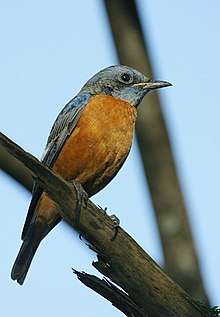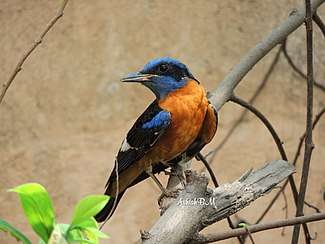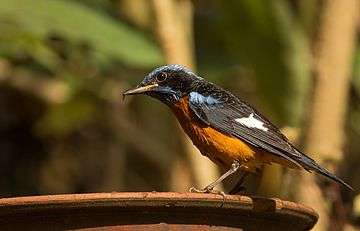Blue-capped rock thrush
The blue-capped rock thrush (Monticola cinclorhyncha) is a species of chat.
| Blue-capped rock thrush | |
|---|---|
 | |
| Scientific classification | |
| Kingdom: | Animalia |
| Phylum: | Chordata |
| Class: | Aves |
| Order: | Passeriformes |
| Family: | Muscicapidae |
| Genus: | Monticola |
| Species: | M. cinclorhyncha |
| Binomial name | |
| Monticola cinclorhyncha (Vigors, 1832) | |
| Synonyms | |
|
Monticola cinclorhynchus | |


Description
The male has a blue head, chin and throat. The upper parts are blue and black. The rump and underparts are chestnut brown. There is a white patch on the wing that is visible during flight. The female bird is brown with a brown and white underside.[2]
Distribution and breeding
This thrush-like Old World flycatcher breeds in the foothills of the Himalayas and winters in the hill forests of southern India. During winter it is found throughout Pakistan, Bangladesh (passage migrant), parts of Myanmar and India, especially in the Western Ghats region.
Habits
Like thrushes, they fly up into trees and sit motionless when they are disturbed.
It is a summer visitor in parts of Afghanistan and along the Himalayas from Pakistan to Arunachal Pradesh. In summer it is found in pine forests and hill slopes. In winter it is found in dense canopied forests.
References

| Wikimedia Commons has media related to Monticola cinclorhyncha. |
- BirdLife International (2012). "Monticola cinclorhyncha". IUCN Red List of Threatened Species. 2012. Retrieved 26 November 2013.CS1 maint: ref=harv (link)
- Ali, Salim (1996). The Book of Indian Birds. India: Oxford University Press. p. 284.
- Rasmussen, P and Anderton, J. C. (2005) Birds of South Asia. The Ripley Guide. Vols 1 and 2. Smithsonian Institution and Lynx Edicions
